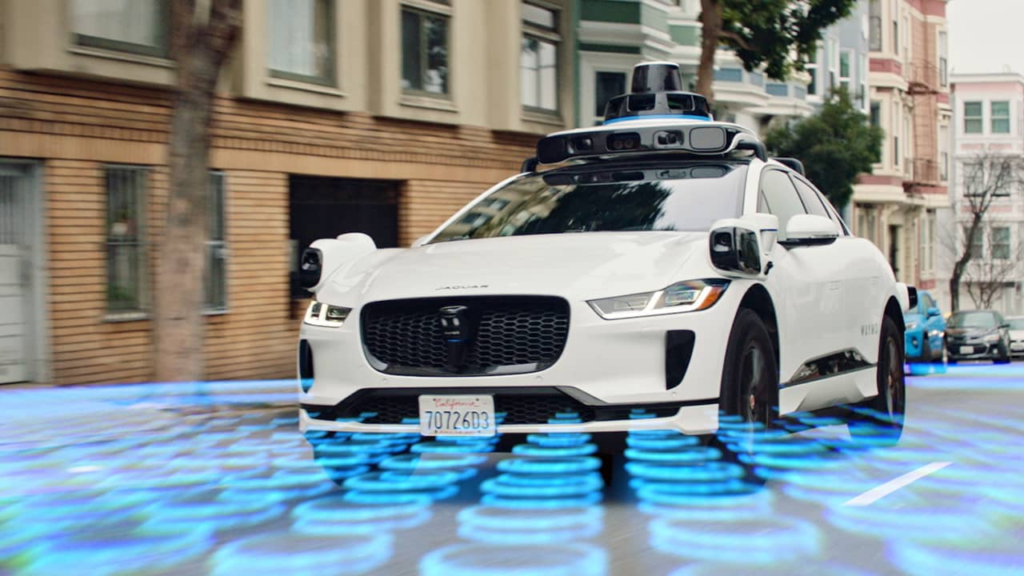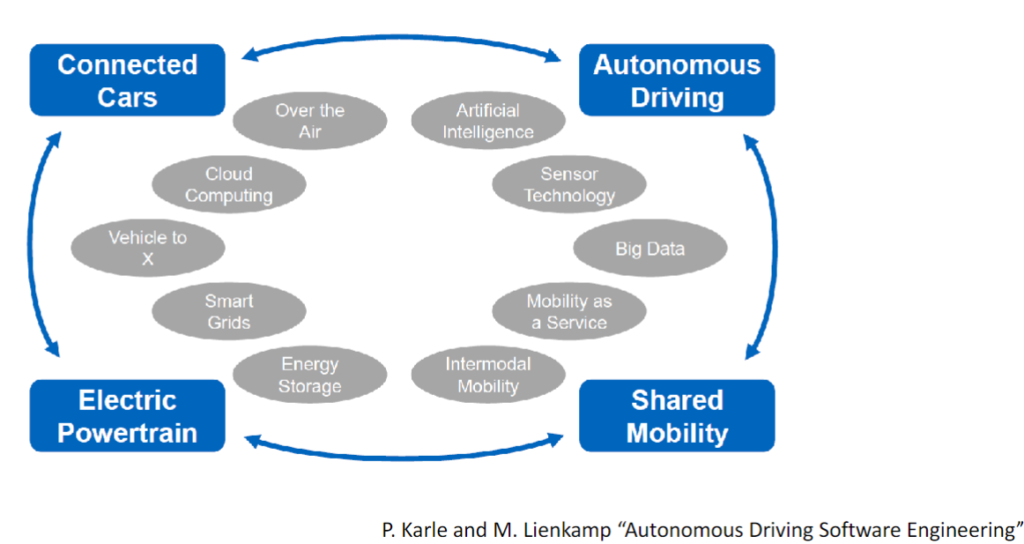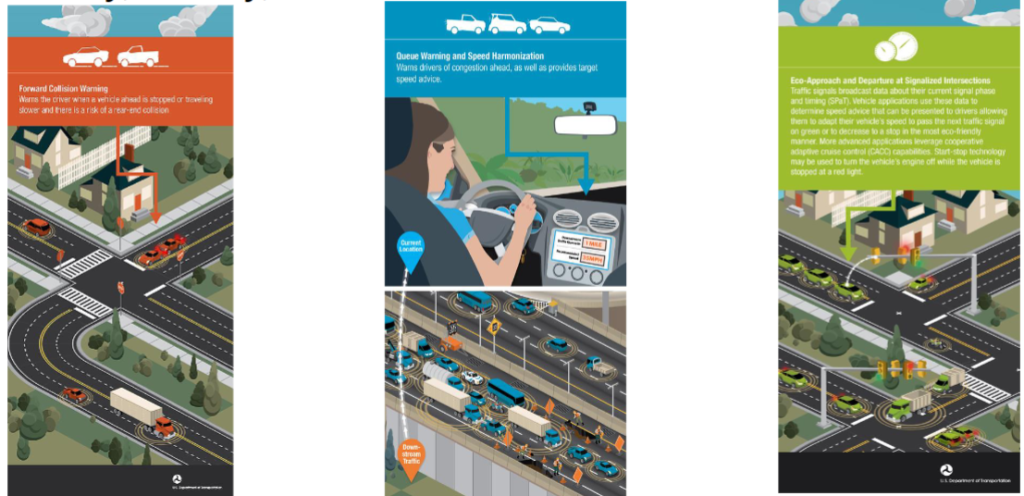Connected and Self-Driving Cars
In the ever-evolving landscape of the automotive industry, four interconnected megatrends are reshaping the way we think about vehicles: vehicle electrification, self-driving cars, vehicle connectivilty and ride sharing. As we hurtle into the future, the race to achieve seamless vehicle connectivity and full automation is on, pushing the boundaries of what was once science fiction. In this article, we’ll delve into the exciting world of automotive innovation, exploring the intricacies of autonomous vehicles, the wonders of vehicle connectivity, and the potential benefits that await us on the road ahead.

In the fast-evolving landscape of the automotive industry, four megatrends have emerged as transformative forces: the rise of, vehicle electrification, self-driving cars, connected cars and the surge in shared mobility. These trends are reshaping the way we think about transportation, challenging traditional notions and paving the way for a more connected and efficient future.

Megatrend 1: Vehicle Electrification
The automotive industry is undergoing a profound transformation, with a shift toward cleaner and more sustainable transportation. Vehicle electrification has become a megatrend, driven by the urgent need to reduce carbon emissions and mitigate the environmental impact of traditional ICE vehicles. Electric vehicles (EVs) have emerged as the pioneers of this revolution, offering a cleaner, greener alternative to their fossil fuel counterparts.
The adoption of EVs is not just a matter of replacing engines; it involves a fundamental redesign of the vehicle’s architecture, integrating advanced battery technologies, electric drivetrains, and sophisticated energy management systems. As automakers strive to electrify their fleets, the race is on to develop more efficient batteries, extend range capabilities, and create a charging infrastructure that can support the growing demand for EVs.
Megatrend 2: Self-driving cars
Parallel to the electrification trend is the relentless pursuit of autonomous vehicles (AVs) – cars that can navigate and make decisions without human intervention. AVs promise a future where transportation is safer, more efficient, and accessible to all. The Society of Automotive Engineers (SAE) has defined levels of vehicle automation from Level 0 (no automation) to Level 5 (full automation). Understanding these levels is crucial in comprehending the progression toward fully autonomous vehicles.
Megatrend 3: Connected cars
Connected cars, equipped with advanced communication technologies, have become the linchpin of the automotive revolution. These vehicles are not just means of transportation; they are intelligent, data-driven platforms that enable seamless communication between vehicles, infrastructure, and the broader transportation ecosystem. This connectivity is unlocking a myriad of possibilities, from enhanced safety features to personalized in-car experiences.
One of the most biggest impacts of connected cars is in the realm of safety. Vehicle-to-vehicle (V2V) communication allows cars to exchange real-time information, enabling features like collision avoidance systems and cooperative adaptive cruise control. Interconnectedness has the potential to significantly reduce accidents and make our roads safer for everyone.
The traditional model of individual car ownership is facing a formidable challenger as more people opt for shared transportation options. Services like ride-sharing, car-sharing, and micro-mobility are gaining popularity, driven by the desire for cost-effectiveness, convenience, and a reduced environmental footprint.
Shared mobility is fostering a shift from a car-centric to a service-centric model. Instead of owning a vehicle, consumers are increasingly relying on on-demand transportation services. The shift not only aligns with the principles of sustainability but also addresses issues of urban congestion and parking challenges. Shared mobility is transforming the transportation sector into a service accessible to all, making it more inclusive and efficient.
What is an self-driving cars?
An autonomous vehicle, often referred to as a self-driving cars or driverless vehicle, is a car, truck, or any other type of vehicle that has the capability to navigate and operate without human intervention. These vehicles use a combination of advanced sensors, cameras, radar, lidar, and artificial intelligence (AI) algorithms to perceive their surroundings, make decisions, and execute actions such as steering, accelerating, and braking.

self-driving cars have the potential to reduce the risk of accidents as they eliminate the element of human error from driving. However, these benefits come with rising energy costs. Power demands by AV electrical/electronic (E/E) systems can reduce vehicle range by over 11.5%.
It is importat to note that regarless of what any automaker calls its advanced driver assistance system (ADAS) technology there are NO full self-diriving vehicles on the road today! The false advertisment from some companies has sparked contraversty if AVs are actually ethical and if the world is actually ready for them.
Are self-driving cars available?
Today, there are no level 5 autonomous vehicles on the road, however certain SAE level 4 highly automated vehicles are operating in several cities such as San Francisco, Phoenix, Los Angeles, Austin Hamburg, and Beijing. However these vehicles still have to opperate within a geofenced area. These vehicles are deployed by companies like Waymo, Zoox and Cruise.
SAE Levels of Vehicle Automation:
Autonomous vehicles are typically categorized into different levels of automation based on the extent of their capabilities, as defined by the Society of Automotive Engineers (SAE). The levels range from Level 0 (no automation) to Level 5 (full automation). At Level 0, the vehicle requires full human control, while at Level 5, the vehicle can operate entirely without any human involvement.
- Level 0: No Automation
- L1: Driver Assistance
- L2: Partial Automation
- L3: Conditional Automation
- L4: High Automation
- L5: Full Automation
What level is Tesla full self-driving?
Tesla’s Full Self-Driving (FSD) is the company’s branding for its beta testing program aimed at achieving full autonomy (SAE Level 5). However branding has sparked controversy because vehicles in the FSD program are currently operating at Level 2 automation, meaning they are not truly “fully self-driving” and require active supervision by the driver.
What is a Connected Vehicle?
A Connected vehicles are at the heart of the automotive revolution, serving as the linchpin between electrification and autonomy. Connected Vehicle technologies aim to tackle challenges in the areas of safety, mobility, and environment.

A connected vehicle is equipped with advanced communication technologies that allow it to interact with other vehicles, infrastructure, and external systems. This connectivity forms the backbone for the seamless integration of various automotive technologies, creating an intelligent and responsive ecosystem.
Benefits of Connected Vehicle Technologies:
Connected and automated vehicle (CAV) technologies provide safety, comfort, and mobility enhancements. CAV technology will also have an positive impact on energy consumption.

- Enhanced Safety: Connected vehicles can communicate with each other to prevent accidents and improve road safety. Features like collision avoidance systems and cooperative adaptive cruise control rely on vehicle-to-vehicle (V2V) communication.
- Traffic Management: With real-time data exchange, connected vehicles contribute to efficient traffic management. This includes dynamic rerouting to avoid congestion, optimizing traffic flow, and reducing overall travel time.
- Predictive Maintenance: Connected vehicles enable continuous monitoring of their components. This allows for predictive maintenance, reducing downtime and extending the lifespan of vehicle systems.
- Infotainment and Comfort: Connectivity enhances the in-car experience, providing passengers with advanced infotainment options, personalized settings, and the ability to seamlessly integrate with smart devices.
Energy Savings via CAV Technologies and ARPA-E NEXTCAR:
The quest for energy efficiency has led to groundbreaking research and development initiatives. Collaborative efforts, such as the ARPA-E NEXTCAR program, focus on developing technologies that optimize energy usage in Connected and Automated Vehicles (CAVs). Greater energy savings can be achieved by adding powertrain optimization with V2X information.

ARPA-E (Advanced Research Projects Agency-Energy) NEXTCAR program:
The ARPA-E NEXTCAR program aims to increase the energy efficiency of vehicles by 20% through the development of innovative technologies. This involves the integration of connectivity, automation, and advanced control systems to optimize vehicle performance and energy consumption.
Conclusion:
The race to achieve vehicle connectivity and full automation is not just a technological sprint but a marathon that involves reshaping the very foundation of transportation. As we witness the convergence of electrification and autonomy, the automotive industry is poised for a paradigm shift that will redefine the way we interact with and perceive vehicles.
The benefits are far-reaching – from cleaner air and reduced carbon footprints to safer roads and enhanced travel experiences. The challenges are equally daunting, requiring collaborative efforts from automakers, technology companies, and policymakers. The road ahead is exciting, filled with innovation, and promises a future where our vehicles are not just modes of transportation but intelligent, connected companions on the journey of progress. So, buckle up, because the race to the future is well underway, and the finish line is on the horizon.






